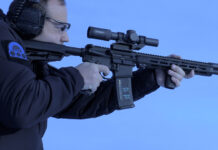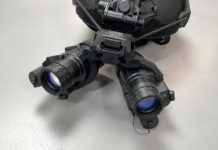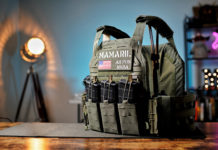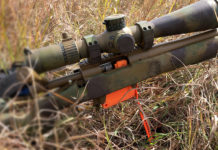[dcs_img_center
framed=”black” w=”600″ h=”450″]
http://gunsandtactics.wpengine.com/wp-content/uploads/2014/02/emr-1-600-450.jpg
[/dcs_img_center]
[dcs_post_top]
[dcs_fancy_header bgcolor=”#ffffff” color=”#000000″ fweight=”bold”]Guns & Tactics Contributor Steve Coulston reviews the Ergonomic Modular Rail (EMR) from ALG Defense.[/dcs_fancy_header]
[dcs_thinspliter size=”medium”]
Despite what some may say, building a top notch quality AR doesn’t need to break the bank. While I do believe you get what you pay for, cost isn’t always directly proportional to a specific level of quality. ALG Defense fits that mold perfectly.
ALG Defense, located in North Wales, PA was founded by Bill and Amy Geissele. If that last name does not ring a bell, it should. Geissele Automatics makes some of the best triggers in the world. ALG is a separate company that was created by Bill and Amy to provide an affordable option for quality gun parts. ALG Defense prides itself in producing high quality, economical triggers, accessories, tools and now rails for the AR platform and they have even worked their way into the Glock arena. I happened to get my hand on their new AR rail offering known as the Ergonomic Modular Rail or the EMR for short.
[dcs_img_center
framed=”black” w=”600″ h=”400″]
http://gunsandtactics.wpengine.com/wp-content/uploads/2014/02/emr-2-600-400.jpg
[/dcs_img_center]
The EMR was designed to fit the M4 carbine flat top upper receivers and its clones. It is basically a simple, extruded aluminum tube that comes in 10, 12 and soon to be released 13 inch lengths. The EMR is a stripped down rail, meaning there aren’t any fixed 1913 picatinny rails adorning the EMR. Instead it has rail stations that run all the way around the tube. This allows the user to position rail sections using whatever configuration works best for them. This includes positions at 90 and 45 degree angles. The EMR comes with three short rail sections. One of the sections is specifically designed to mount at the 12 o’clock position in order to co-witness with the upper receiver flat top rail. This means the front and rear sights, if used, will align properly. The rail sections are secured in place with two flat head cap screws that mate with a sliding nut. The sliding nut is much easier to use than a pair of smaller traditional nuts and is one less thing to lose out in the field.
[dcs_img_center
framed=”black” w=”600″ h=”400″]
http://gunsandtactics.wpengine.com/wp-content/uploads/2014/02/emr-3-600-400.jpg
[/dcs_img_center]
The absence of full length rails reduces the overall weight of the rail. The EMR I had on hand was of the 12 inch persuasion and weighed in at a svelte 7.84 oz, less the barrel nut. It has a slender profile with an outside diameter of 1.75 inches with an inside diameter of 1.46 inches. Note this inside diameter will most likely prevent the installation of a sound suppressor within the tube as most traditional and popular sound suppressors have an outside diameter of 1.5 inches.
The EMR tube has ribs that run the entire length of the rail cutting down on the amount of material used as well as providing a more aggressive gripping surface. Breaking up the ribs are generous ventilation ports. These ports further reduce the weight while allowing for ample air cooling. There are also two integral QD attachment points toward the rear of the rail for sling attachment points. At the rear of the EMR is where six button head cap screws secure the EMR to the barrel nut. To prevent the rail from rotating there are two anti-rotation tabs that slide under the receiver top rail.
[dcs_img_center
framed=”black” w=”600″ h=”400″]
http://gunsandtactics.wpengine.com/wp-content/uploads/2014/02/emr-4-600-400.jpg
[/dcs_img_center]
Installation of the EMR is simple and straight forward, but can take a little time. The time part is due to the fact that stainless steel shims must be used to time the barrel nut in order to allow the gas tube to properly be inserted into the upper receiver. The EMR comes with detailed instructions on how to use the shims and what position the barrel nut must be in prior to finally tightening it down with the provided barrel nut wrench. It should be noted the shims are not an option. They must be used. If not, the barrel nut will be in contact with the aluminum upper and grind and potentially damage the aluminum upper receiver during the tightening process. Once the barrel nut is properly timed and secured, the EMR simply slides over the barrel and is secured to the barrel nut with the above mentioned cap screws. This allows for a true free floated barrel. Note if the EMR will extend past the gas block a low profile block must be used. Also, this is for direct impingement gas guns only. ALG has not tested these rails with piston driven systems yet.
[dcs_img_center
framed=”black” w=”600″ h=”400″]
http://gunsandtactics.wpengine.com/wp-content/uploads/2014/02/emr-5-600-400.jpg
[/dcs_img_center]
The EMR makes for a welcomed addition to anyone looking to complete a feather weight build. My only criticism for the EMR was that it doesn’t come with a removable full length top rail. In fact, I don’t believe one can be ordered separately at this time. As someone who prefers to mount their red dot and magnified optics a little further forward, the additional top rail space would be a nice option. Even still, I am very happy with the EMR and its minimalist design and weight savings. The Ergonomic Modular Rail can be ordered direct from ALG Defense.
MSRP will range from $135 to $155 depending on the length ordered.
Learn more at http://algdefense.com/rails.html.
[dcs_rounded_box padding=”15px” margin=”24px 0px 0px 0px”]
Want more posts like this one? Subscribe to Guns & Tactics Magazine to receive email updates and special offers direct to your inbox!
[/dcs_rounded_box]
[dcs_post_bottom]
[dcs_post_author]
[dcs_related_posts]












